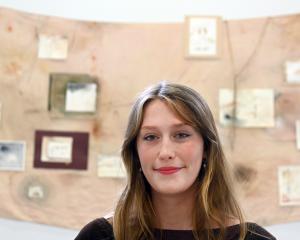Shiny machines promising the perfect body of one's lost youth, the pain hoping for gain of an unachievable aspiration - "Gymnauseum" at Dunedin Public Art Gallery explores the other side of the fitness industry.
Charmian Smith talks to creator Jane Venis.
Her exhibition, "Gymnauseum", which is on show at the Dunedin Public Art Gallery, makes humorous but cynical comments about popular culture, and in particular the fitness industry.
Making social comment is an artist's role, she says.
She is also intrigued by Kiwi mythologies. Earlier works explored the mythical Southern Woman, the invisible counterpart of the stoic, silent Southern Man developed by beer marketers.
"Who is Southern Woman and what does she do? I was also interested in what rural women did, baking scones, feeding endless shearing gangs. An early work was Southern Woman making a mountain of scones called Sconehenge," she said.
In "Gymnauseum", she takes on overweight babyboomers wanting to regain the bodies of their lost youth by exercising.
The gallery is filled with her shiny "gym" equipment, fetishistic punchbags in wet-look black vinyl with chains and chrome spikes, or that cry for mercy when hit, and other sleek machines in chrome, with black fur and mirrors, that turn exercise on its head.
Venis is also fascinated by chindogu, the Japanese art of creating things that are totally useless, although you may not realise just how useless they are until you try to use them, she says.
"I think of the ageing body as a kind of chindogu because we always try to obtain something that's unobtainable - to be perfectly fit and healthy and able as we are getting older."
A lot of home gym equipment is marketed to middle-aged baby-boomers now in their 50s, because they have money as well as aspirations to regain their lost youthful bodies.
"I started thinking how contemporary home-gym equipment is already chindogu - the bicycle that goes nowhere and the rowing machine you row on dry land.
"The gym as a system can be somewhat chindogu, too, with endless people on treadmills all trying to obtain something they can't ever reach."
Venis observed people in gyms for the project and discovered some interesting behaviour.
"A lot of people go to the gym to pose and wander around with their towels around their neck and don't actually do a huge amount," she said with a laugh.
One of her sculptures, a low-rider bike from the 1970s transformed into a quirky, shiny chrome exercycle, has a bevy of mirrors on the handlebars.
"I'm talking about baby-boomers being part of this work, being a baby-boomer myself. Lots of people are going to have fun with mirrors and when you go to the gym there are mirrors everywhere, but these ones you can focus on your own problem areas or if it's more fun you can focus on other people while you are exercising," she said.
Another heavily chromed low-rider exercycle has a sidecar with a 1960s hairdrier designed for beehive hairdos attached at the back. Sidecar of Desire is fitted with black fake fur and has a video screen for the person using it.
"We have the person who is tired of being told they should be exercising. Sure, somebody else can be riding the bike and getting all hot and sweaty but this person here can be relaxing in the sidecar of the exercycle."
On the screen is a video of the Absolution machine that gives you great abs, and the fatter you are the better it works - it's twisting things around a bit, she said.
Other machines, instead of showing your heart rate, show your stomach contents or BMI and other useless information.
Part of the inspiration for the show was reality TV, which Venis describes as a modern freak show.
"Reality TV is beamed 24/7 into people's homes, yet we believed ourselves to be beyond things like exploiting people in freak shows. And yet it seems to have worsened.
"I'm looking at the way overweight people have become this sort of compelling spectator sport - things like The Biggest Loser and the Big Fat Family Challenge," she said.
So many programmes had us ogling people with different body shapes, and probably eating food we didn't need at the same time, while governments were spending huge amounts telling us what we should be eating and promoting healthy lifestyles.
Part of that paradox is reflected in the chindogu of "Gymnauseum.".
See it
"Gymnauseum" by Jane Venis is at the Dunedin Public Art Gallery until December 11.












